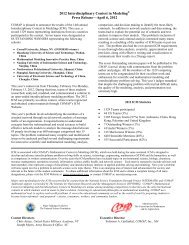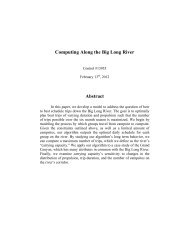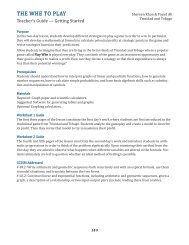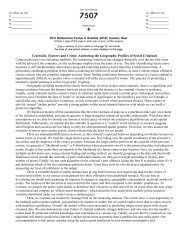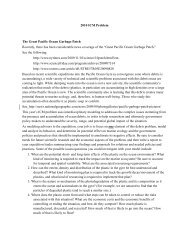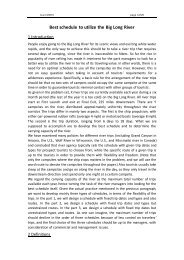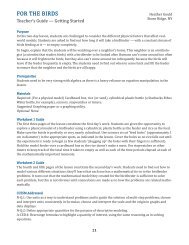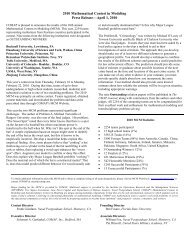Team 9159: Higher in the Air: Design of Snowboard Course
Team 9159: Higher in the Air: Design of Snowboard Course
Team 9159: Higher in the Air: Design of Snowboard Course
Create successful ePaper yourself
Turn your PDF publications into a flip-book with our unique Google optimized e-Paper software.
<strong>Team</strong> # <strong>9159</strong> page21 <strong>of</strong> 22<br />
8 Conclusion<br />
In this paper, we study <strong>the</strong> shape <strong>of</strong> a snowboard course and its <strong>in</strong>fluential<br />
factors under energetic view. The ma<strong>in</strong> idea is to measure <strong>the</strong> ”vertical air” by<br />
f<strong>in</strong>al energy. After mak<strong>in</strong>g several assumptions, we build our basic model, which<br />
is simple but sufficient to <strong>of</strong>fer a fundamental idea and reveal essential <strong>in</strong>teractions<br />
among different factors. We make force analysis, set up k<strong>in</strong>ematical equations and<br />
obta<strong>in</strong> <strong>the</strong> general form <strong>of</strong> f<strong>in</strong>al mechanical energy analytically.<br />
After that, two specific types <strong>of</strong> transition curve are <strong>in</strong>troduced to calculate <strong>the</strong><br />
optimal design. In quarter-circle model, we obta<strong>in</strong> analytical solutions and f<strong>in</strong>d<br />
<strong>the</strong> best radius R ∗ <strong>of</strong> <strong>the</strong> circle. While <strong>in</strong> quarter-ellipse model, we use numerical<br />
simulation to get <strong>the</strong> optimal semi-major axis a ∗ and semi-m<strong>in</strong>or axis b ∗ . Then we<br />
fur<strong>the</strong>r develop <strong>the</strong> 2D quarter-ellipse model <strong>in</strong>to a more actual and complex case,<br />
<strong>in</strong>volv<strong>in</strong>g <strong>the</strong> third dimension <strong>of</strong> <strong>the</strong> halfpipe. Through numerical computation, we<br />
f<strong>in</strong>d <strong>the</strong> most suitable slope angle <strong>of</strong> <strong>the</strong> halfpipe is 17.1 o . Next, <strong>the</strong> sensitivities <strong>of</strong><br />
different variables are analyzed both qualitatively and quantitatively. It helps us<br />
to compare <strong>the</strong> significance <strong>of</strong> <strong>the</strong>se variables <strong>in</strong> build<strong>in</strong>g a best halfpipe.<br />
At last, <strong>the</strong> tailors and trade<strong>of</strong>fs to develop a ”practical” course are discussed.<br />
After tak<strong>in</strong>g construction difficulty, players’ safety and <strong>the</strong>ir performance <strong>in</strong>to consideration,<br />
our result becomes more practical.<br />
In conclusion, through systematic and comprehensive analysis <strong>of</strong> various factors,<br />
we f<strong>in</strong>d a reasonable shape <strong>of</strong> <strong>the</strong> snowboard course, with a = 4.42m, b = 5.4m and<br />
ϕ = 17.5 o . Our results fit <strong>the</strong> real date well.<br />
References<br />
[1] http://www.stuff.co.nz/southland-times/sport/2705175/cardronas-halfpipeopens-for-season.<br />
[2] http://en.wikipedia.org/wiki/half-pipe.<br />
[3] International Ski Federation. <strong>Snowboard</strong> resort <strong>in</strong>formation sheet.<br />
21







